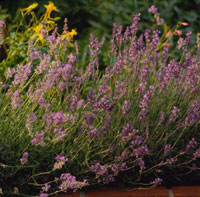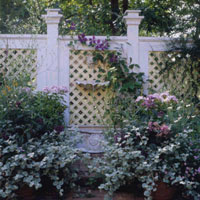Today, herbs play an integral role in nearly every home garden. The favorite way of growing them continues to be in tidy little beds all their own, but more gardeners are liberating herbs from herb gardens and experimenting with them in all areas of the landscape. If you're interested in breaking your herbs out of confinement, give these techniques a try:
continue reading below

Lavender is a popularlandscaping herb.
- Mix herbs with flowers. Many herbs have such beautiful flowers that the uninitiated will never know they're actually herbs. Varieties with striking flowers include catmint, borage, bee balm, yarrow, pinks, lavender, purple coneflower, pot marigold, feverfew, and nasturtium. Many other herbs, such as parsley, have beautiful foliage that makes an excellent foil to flowers of all sorts. Try placing purple basil next to red or blue flowers. Complement white or blue blooms with the silver-gray leaves of Artemisia.
Learn how to use herbs to make your own infused vinegar.
- Use herbs as a groundcover. Low-growing, spreading herbs create a groundcover that's as fragrant as it is attractive. Oregano, chamomile, woolly and other creeping thyme, mint, and prostrate rosemary are all good choices.

Containers provide the
excellent drainage that
many herbs require.
- Plant herbs in containers. Many herbs demand first-rate drainage, and containers deliver. Whether you're planting in pots, planters, window boxes, or hanging baskets, you can grow enough of an herb to use it frequently. Containers make perfect planters for herbs that aren't winter-hardy in many parts of the country, including scented geraniums, bay, and rosemary. Gardeners in cold climates should bring potted herbs inside during winter and set them outdoors again in spring. Nearly all the annual culinary herbs, such as parsley, cilantro, and basil, work well in containers.
- Create an edging of herbs. Plants at the front of a flowerbed or border need to look first-rate all season long, and herbs fit the bill. Classic edging herbs include chives, lavender, lavender cotton, and lamb's-ears.

When landscaping with herbs,
consider different colors.
- Tuck herbs into cracks and crevices. Many herbs, such as thyme, lavender, and oregano, originated on rocky hillsides and are well-suited to growing in the cracks of flagstone paths, stone walls, rock gardens, or any other hot, dry place with poor soil and good drainage. In fact, these herbs often produce better flavor and scent in these poor conditions.
- Use herbs in landscaping. Even among foundation trees and shrubs and other landscaping, herbs are a good addition. In warmer parts of the country, rosemary (which can be clipped into formal shapes) and germander make ideal shrubs, while bay is an attractive tree. Herbs also can be used as groundcovers to weave around conventional trees and shrubs.






 Lavender is a popularlandscaping herb.
Lavender is a popularlandscaping herb.
 Containers provide the
excellent drainage that
many herbs require.
Containers provide the
excellent drainage that
many herbs require.
 When landscaping with herbs,
consider different colors.
When landscaping with herbs,
consider different colors.